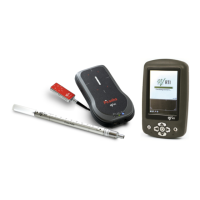2. Description of the Piranha
Hardware and Specifications
Piranha & QABrowser Reference Manual
2014-06/5.5C
26
2.4.2 Piranha External Probes
The inaccuracy is here defined as the root of the square sum of systematic errors,
which has not been eliminated, and random errors (dispersion around a mean value).
The calculation of the inaccuracy is based on 15 different measurements and with a
confidence level of 95 %. Of the total inaccuracy, random error is 20 % and general
inaccuracy is 80 %.
Note: Irradiation time is often called exposure time in daily use.
Reference conditions
Radiation quality
Radiography
Mammography
CT
70 kV, 2.5 mm Al
28 kV, 30 µm Mo
120 kV, 2.5 mm Al
Note: The reference conditions are given in reference to the IEC61674 standard.
General
Hirose ST40X-10S with built-in detector identification.
Measuring range and inaccuracy
The detector noise given is typical values at room temperature.
- Piranha External Dose Probe (typical sensitivity +55 µC/Gy)
100 pGy – 1.5 kGy
12 nR – 170 kR
Air kerma rate
(Dose rate)
(5 s moving average)
4 nGy/s – 150 mGy/s
460 nR/s – 16 R/s
26 µR/min – 1000 R/
min
1.6 mR/h – 60 kR/h
1 nGy/s – 150 mGy/s
(valid for Irr. time >20 ms)
±5 % or ±1 nGy/s
±5 % or ±100 nR/s
±5 % or ±6 µR/min
±5 % or ±360 µR/h
±5 % or ±250 pGy/s
0.1 ms – 34000 s
1 – 65535 pulses
Note 1: The air kerma rate is calculated as the air kerma divided by the time. See also Waveforms
and Triggers .
Note 2: The standard calibration for the Piranha External Dose Probe is W/23 mm Al. This
calibration was chosen since the main use of the detector is to measure the dose to the image
intensifier, after the phantom. However, you can just as well use this probe for measurements of
skin dose. The detector is very linear in its energy response and will not be affected by a different
filtration.
82

